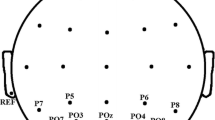Abstract
In this paper, electroencephalogram (EEG) signals of 20 subjects are classified in a steady state visual evoked potential (SSVEP) based brain computer interface (BCI) system by using 4 different stimulation frequencies in a program created by Visual C#. After applying proper pre-processing methods, power spectral density (PSD) based features are extracted around first and second harmonics of the stimulation frequencies. Average classification performance obtained from 20 subjects in 4-class classification is 83.62% with Nearest Mean Classifier (NMC). Results for 5-class classification, EEG segment size and gender differences are also analyzed in a detailed manner. The classification method is simple and very suitable for real-time experiments.
Access this chapter
Tax calculation will be finalised at checkout
Purchases are for personal use only
Preview
Unable to display preview. Download preview PDF.
Similar content being viewed by others
References
Friman, O., Volosyak, I., Gräser, A.: Multiple Channel Detection of Steady-State Visual Evoked Potentials for Brain-Computer Interfaces. IEEE Transactions On Biomedical Engineering 54(4), 742–750 (2007)
Srinivasan, R., Bibi, F.A., Nunez, P.L.: SSVEPs: Distributed Local Sources and Wave-like Dynamics are Sensitive to Flicker Frequency. Brain Topography 18(3), 167–187 (2006)
Maggi, L., Parini, S., Piccini, L., Panfili, G., Andreoni, G.: A four command BCI system based on the SSVEP protocol. In: Proceedings of the 28th IEEE EMBS Annual International Conference, New York, pp. 1264–1267 (2006)
Mukesh, T.M.S., Jaganathan, V., Reddy, M.R.: A novel multiple frequency stimulation method for steady state VEP based brain computer interfaces. Physiological Measurement 27, 61–71 (2006)
Brain Products GmbH - Solutions for neurophysiological research, http://www.brainproducts.com
Trejo, L.J., Rosipal, R., Matthews, B.: Brain–Computer Interfaces for 1-D and 2-D Cursor Control: Designs Using Volitional Control of the EEG Spectrum or Steady-State Visual Evoked Potentials. IEEE Transactions on Neural Systems And Rehabilitation Engineering 14(2), 225–229 (2006)
Müller-Putz, G.R., Pfurtscheller, G.: Control of an Electrical Prosthesis With an SSVEP-Based BCI. IEEE Transactions on Biomedical Engineering 55(1), 361–364 (2008)
PRTools: The Matlab Toolbox for Pattern Recognition, http://www.prtools.org/
Duda, R.O., Hart, P.E., Stork, D.G.: Pattern classification, 2nd edn. John Wiley & Sons, New York (2001)
Allison, B.Z., McFarland, D.J., Schalk, G., Zheng, S.D., Jackson, M.M., Wolpaw, J.R.: Towards an independent brain–computer interface using steady state visual evoked potentials. Clinical Neurophysiology 119, 399–408 (2008)
Author information
Authors and Affiliations
Editor information
Editors and Affiliations
Rights and permissions
Copyright information
© 2011 Springer-Verlag Berlin Heidelberg
About this paper
Cite this paper
İşcan, Z., Özkaya, Ö., Dokur, Z. (2011). Classification of EEG in A Steady State Visual Evoked Potential Based Brain Computer Interface Experiment. In: Dobnikar, A., Lotrič, U., Šter, B. (eds) Adaptive and Natural Computing Algorithms. ICANNGA 2011. Lecture Notes in Computer Science, vol 6594. Springer, Berlin, Heidelberg. https://doi.org/10.1007/978-3-642-20267-4_9
Download citation
DOI: https://doi.org/10.1007/978-3-642-20267-4_9
Publisher Name: Springer, Berlin, Heidelberg
Print ISBN: 978-3-642-20266-7
Online ISBN: 978-3-642-20267-4
eBook Packages: Computer ScienceComputer Science (R0)




